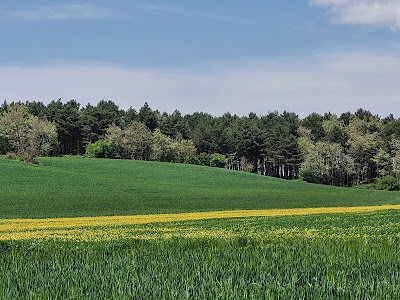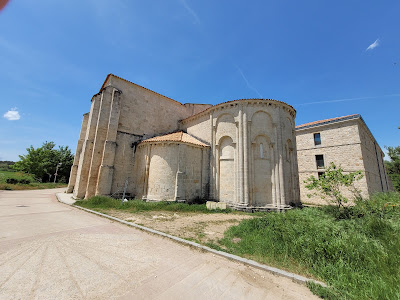We loved being in Belorado. We stayed at this hostel with one of the kindest gentlemen we have met. Not only did he provide us with an amazing meal...
... but spent time interacting with us. It all started when we sang a couple of our songs for him (which attracted people from the street). People were taking pictures of us and clapping. He loved it! After we had finished he grabbed his harmonica and played for us... He was delightful.
Later he spent time with us singing. Good memories!
Here is our exit from the city with its multitude of wall murals:
For the most part the trek today was "normal," going through rolling hills. I had a wonderful conversation with a couple from Madrid.
Again, we went through some beautiful terrain. Here are some scenes:
These are the remains of the 9th-century Monasterio de San Félix de Oca. Here is where Count Diego Porcelos, the founder of Burgos, was once buried here.
Once we got to Villafranca and the Montes de Oca everything changed. Those rolling hills turned into constant climbs over several kilometers. Even though there were some downhill sections, it all felt uphill.
This is Villafranca and those mountains in the background are the ones that climbed to get to our destination! Up and over!
Parts of the climb through the mountains are shaded while others are open tracks.
At the highest point of the trail we came across a memorial dedicated to over 300 Spaniards from the area who were shot and buried in common graves in 1936 at the beginning of the Spanish Civil War. They were victims of Francisco Franco's nationalist ideology that condemned any and all individuals who disagreed with his right-wing politics.
This marks one of the common graves that have been discovered.
From this somber moment we move forwards on a slight descent towards San Juan de Ortega.
Near the top is a place known simply as the "Oasis." There is a man (a very funny guy) who for years has sold drinks, fruit, and candy to pilgrims. You see, from Villafranca to San Juan de Ortega there isn't a single town for nearly 11 kilometers. He has created a very humorous setting where pilgrims can rest. Part of his "Oasis" is made up of painted logs and figures:
He is a little nutty and a lot eccentric!
Once we dropped out of the mountains things return to a semblance of what we have seen along the way. A lot greener.
And then, we see the Church. We have arrived!
The Church in San Juan de Ortega is simple yet filled with beautiful and unique pieces of art and architecture.
This beautiful crypt (15th century gothic) with the effigy of San Juan de Ortega is located in the nave of the church.
The original sarcophagus for San Juan de Ortega (1080-1163) was an elaborately carved piece (below).
However, for fear that people might attempt to remove bones as "relics," the saint's body was placed in a more modest sarcophagus that now sits in the chapel of the original church that he built.
One of the true treasures of the church is this capital that depicts the Nativity cycle.
To the left is the Annunciation with the Angel Gabriel. This particular part of the capital is unique in that during the winter and summer solstice at around 5 pm a ray of light from an upper window falls on Mary's womb. The light alters the appearance of her face giving it a glow. To the right is the Visitation when Mary greets Elizabeth.
This is the Nativity. In the center is Mary with the midwife sustaining her in her arms. To the left is Joseph with is eyes closed; this is moment when the angel tells him to care for Mary and to not put her away. This representation is particularly beautiful as the angel leans his head on to that of Joseph in a loving gesture.
A close up of the midwife and Mary.
It was harder to catch the backside of the capital because it was in near darkness. You can see that it is the announcement from the angels to the shepherds that the Christ child had been born.
In the opposite transept of the church is this capital that represents the battle between Roland (one of Charlemagne's soldiers; the subject of epic poem The Song of Roland) when he fights Farragut the giant. For pilgrims this is a significant story since most either pass through or begin their journey on the Camino at Roncesvalles where Roland fought against the Moorish invaders.
Tomorrow we are off to Burgos!!!!





































No comments:
Post a Comment